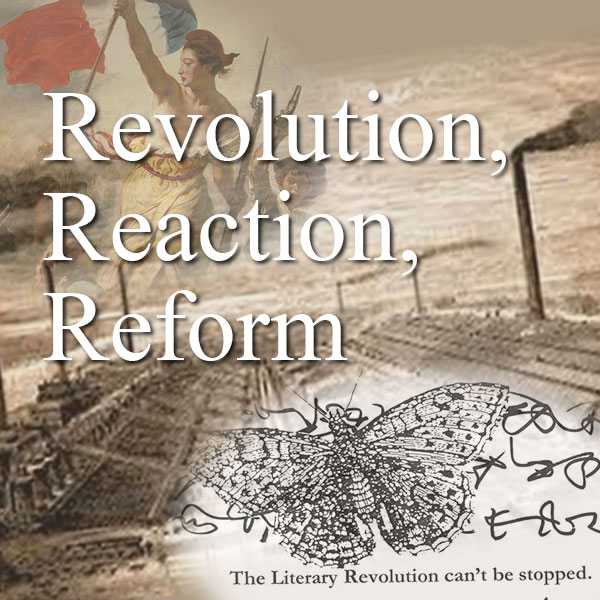The timeline for my final project in British Literature 272, in which I analyze literature through its approximation to the awful acts and cascading impacts that humans are capable of.
MSSU ENG272 - Spring 2025 Dashboard
Description
 British Literature II: Revolution, Reaction, Reform examines British literature from the late eighteenth century to the present, a period that witnessed the American and French Revolutions, slave revolts such as the Haitian Revolution, a “revolution in female manners,” the Industrial Revolution, the twentieth-century revolutionary wave in Europe, as well as World War I and World War II, and, of course, artistic revolutions. We will consider how the authors and literary works of this period might be reacting to change, advocating for reform, or participating in literary revolutions—whether revolution is understood in the sense of “revolving” or of “revolting,” going full circle to return to a previous (more perfect?) time or experiencing/effecting a great alteration or rupture.
British Literature II: Revolution, Reaction, Reform examines British literature from the late eighteenth century to the present, a period that witnessed the American and French Revolutions, slave revolts such as the Haitian Revolution, a “revolution in female manners,” the Industrial Revolution, the twentieth-century revolutionary wave in Europe, as well as World War I and World War II, and, of course, artistic revolutions. We will consider how the authors and literary works of this period might be reacting to change, advocating for reform, or participating in literary revolutions—whether revolution is understood in the sense of “revolving” or of “revolting,” going full circle to return to a previous (more perfect?) time or experiencing/effecting a great alteration or rupture.
Access the works for annotations assignments in COVE Studio here: ENG 272, Spring 2025
The digital edition of Frankenstein for annotations and the map project can be found here: Mary Shelley, Frankenstein (1818)
Galleries, Timelines, and Maps
By Ford Madox Brown - http://www.artchive.com/artchive/B/brown/brown_work.jpg.html, Public Domain, https://commons.wikimedia.org/w/index.php?curid=4454264
This timeline follows writers who observed injustice, and those who experienced it. Through these events, I follow writers who felt they had a responsibility to call out systemic issues within the British Empire; to change them in any way they could, and to give voice to those who were denied rights,...
moreThe main objective of my work is analyze how the value given to people as individuals, as specific groups and as colelctives highly fluctuated during the last 250 years of British history. This map will show places important for the breakpoints on how the people's perceived value changed.
These mapped moments trace not just places, but pulses; points where something in the art shifted, where emotion sharpened into form. Each one holds more than setting; it holds pressure, identity, change, imaginations. As I map these moments, I wasn’t just locating stories; I was watching art step into risk and confrontation, into tenderness. These places aren't just ground beneath the writers' feet, but places where art rose though their pages.
Throughout British literature, art serves as both a mirror and a weapon: it reflects personal and cultural crises while also offering a means of resistance, survival, and redefinition. These timelines trace key moments when art refuses to remain passive, when it dares to protest, to heal, mislead, or to confront. Drawing from major works across British literary history, each of these entries reflect on a cultural or personal turning point where artistic expression shapes, challenges, or fails to live up to its imagined power.
In Great Britain, on the almost 250 years of history that we reviewed in this class, the value given to individual by society, government and individuals themselves have vary through time, as well as for other factors like sex, age, race, ethnicity, sexual orientation, nationality, etc. This is actually reflected on many of the texts that we analyzed, either directly by addressing the topic or indirectly by looking at how characters interact with each other. In this timeline, I want to look at some events that are either a good example of this difference in people's value or breaking points that changed the perception of how valuable individuals or a particular group were for society.
This project will demonstrate how British literature has both reflected and influenced the evolving roles of women over the past 250 years. By examining these texts, we can gain a deeper understanding of the challenges women have faced and the progress that has been made in the fight for gender equality.
Through their groundbreaking works Anna Letita Barbauld, Mary Wollstonecraft, Mary Shelley, Christina Rossetti, and Chimamanda Ngozi Adichi have not only enriched British Literature, but also challenged societal norms, and championed individual rights and empathy.
This map will show places that are relevant to these female authors lives, they are the pleaces that helped shape these womens voices, and inspired their writings.
This gallery exhibit connects to the theme of my project "what makes us human?" These pictures will likely have to do with authors who have written stories that talk about aspects of human nature.
This map has to do with my final project's theme: what makes us human? The locations on this map will either be related to stories that revolve around this theme, or they will be birth places of certain authors, or places that are important to authors.

